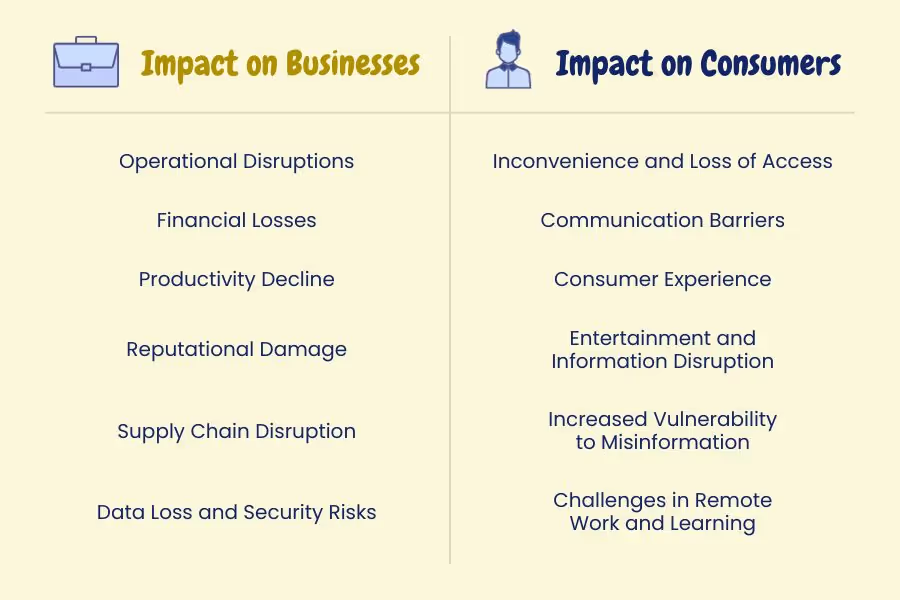Global vs Local Outage: Understanding the Differences
In our increasingly interconnected world, the reliability of Internet services is more critical than ever. Both businesses and consumers depend heavily on uninterrupted online connectivity for various activities, from daily communications to complex business operations. However, internet services are not immune to disruptions, and outages can occur on both a global and local scale. To handle internet disruptions well, it's important to know how to respond to the different challenges that global and local outages bring. In this article, we will examine the intricacies of global vs local outages, exploring their causes, impacts, and strategies for recovery and learning from such events.

What are Global Outages?
Global outages are significant disruptions in internet services that happen on a large scale. These outages aren't just in one place; they can affect many countries and continents at the same time. Imagine the internet as a vast network connecting different parts of the world. During a global outage, large parts of this network stop working properly.
This means that many people and businesses around the world cannot access websites, online services, and other internet-based resources. It's like a major highway that connects cities suddenly getting blocked, impacting all the traffic that depends on it.
The primary causes of global internet outages often trace back to major network companies, particularly Content Delivery Network (CDN) providers. These outages are frequently the result of configuration errors that get propagated across the network, or bugs in newly deployed software that hinder traffic delivery.
Contrary to common belief, local Internet Service Providers (ISPs) or hardware issues are typically not responsible for these global disruptions. Such outages underscore the complex nature of internet infrastructure and the critical role played by key network companies in maintaining global connectivity.
When a global outage happens, it has a wide-reaching effect. It can stop people from sending emails, using social media, streaming videos, or doing online transactions. For businesses, this can mean a big loss, as they might not be able to operate online, communicate with customers, or access important data.
{{promo}}
What are Local Outages?
Local outages are disruptions in internet services that happen in a specific, limited area. Unlike global outages that affect vast regions, local outages are confined to a smaller scope, such as a particular city, neighborhood, or even a single building. Think of it as a small roadblock on a neighborhood street rather than a closure of a major highway.
These outages can be caused by various issues that are more localized in nature. For instance, they might happen due to problems with the local internet infrastructure, like a damaged cable in a specific area. They can also be caused by hardware failures, such as a router or a switch going down in an office, or by configuration errors in local network settings.
The impact of local outages extends beyond mere lack of connectivity. When a local Edge Point of Presence (Edge PoP) experiences an outage, it leads to the rerouting of end users to alternative Edge PoPs. This rerouting has two significant negative implications for performance:
- Increased Distance: The rerouted traffic has to travel a considerably longer distance as end users are connected to a farther Edge PoP. This increased distance can lead to higher latency, slowing down the user experience.
- Cold Cache Impact: The alternative Edge PoP may not be primed with frequently accessed data, known as a 'cold cache'. This situation results in a high number of cache misses. As a result, the system has to retrieve data from the origin server more often, leading to slower response times and increased load on the origin server.
While local outages typically have a more limited scope, affecting only a subset of end users, their impact on these users can be significant. Unlike global outages, which affect all users of an online service, local outages are confined to specific geographical areas or user segments. However, for those within the affected area, the consequences can be just as disruptive.
Local outages are generally caused by issues within specific components or local networks, and although they might be easier to isolate and address, the effect on the affected users' ability to connect to the internet, access online services, or communicate digitally can be substantial. For businesses in these areas, especially those relying heavily on online systems, the operational disruptions can be critical.
Analyzing the Causes of Outages

Every outage comes from a cause, be it big or small. You can aim to develop more robust systems and contingency plans, but nothing is fool-proof, and that’s where you need reliability.
Aside from the niche cases, global and local outages are the result of the following factors:
1. Infrastructure Failures
- Global Outages: These often occur due to failures in major infrastructure components that support the global internet network. This includes buggy configuration and SW updates.
- Local Outages: These often stem from issues within smaller-scale infrastructure, like local cables, routers, or switches. Damage can result from construction work, weather-related events, or hardware malfunctions.
Local CDN outages, especially at Edge Points of Presence (PoPs), can significantly affect content availability and performance in specific areas. When an Edge PoP goes offline, users in that area may face difficulties accessing content or experience slower performance due to increased latency and higher cache misses. This local disruption highlights the crucial role of Edge PoPs in maintaining efficient content delivery within a CDN.
2. Software and Configuration Errors
- Global Outages: These can happen due to bugs or errors in software that manages critical internet infrastructure. Incorrect routing information or faulty updates can disrupt the normal flow of internet traffic on a massive scale. These are also the key reason for such outages.
- Local Outages: Software issues at a local level may include incorrect network configurations, failed updates, or software glitches in local servers or networking devices. However, this seldom happens since the software/infrastructure is tailored for a certain goal.
3. Overload and Capacity Issues
- Global Outages: Sometimes, the sheer volume of internet traffic can overwhelm global networks, especially during peak usage times or unexpected surges (like during global events). Popular examples include Fortnite’s Travis Scott concert, and OpenAI’s API outage.
- Local Outages: Local networks might experience outages when they cannot handle the amount of traffic or data being processed, often due to inadequate capacity planning or unexpected spikes in usage. This leads to traffic re-routing to other locations, which causes significant performance issues.
4. Human Error and Accidental Damage
- Human error is a common factor in both global and local outages. This can include misconfiguration of network settings, or erroneous manual overrides of automated systems.
5. Power Failures
- Local outages can be triggered by power failures. At a local level, power issues can disrupt local servers and networking equipment.
Impact on Businesses and Consumers

The impact of both global and local internet outages extends far beyond mere inconvenience. These disruptions can have significant consequences for businesses and consumers alike, affecting various aspects of daily life and operations.
Impact on Businesses
- Operational Disruptions: Businesses heavily reliant on internet connectivity for their operations can face significant challenges during outages. This includes difficulty in accessing cloud services, disruptions in communication channels, and inability to perform online transactions.
- Financial Losses: Outages can lead to direct financial losses, especially for online retailers, service providers, and digital platforms. Even a short period of downtime can result in lost sales, diminished customer confidence, and potential contractual penalties.
- Productivity Decline: In the corporate world, an outage can halt productivity. Employees may be unable to access essential tools and information, leading to delays in projects and deadlines.
- Reputational Damage: Frequent or prolonged outages can harm a business's reputation. Customers may perceive the company as unreliable, potentially leading to a loss of clientele and a negative impact on brand value.
- Supply Chain Disruption: For businesses that are part of a global supply chain, outages can disrupt communication and logistics, leading to delays and operational inefficiencies.
- Data Loss and Security Risks: During outages, there's a risk of data loss, especially if backup processes are interrupted. Additionally, the period immediately following an outage can be vulnerable to cyberattacks, as systems are restored and security may be compromised.
Impact on Consumers
- Inconvenience and Loss of Access: Consumers may lose access to essential services like online banking, shopping, and communication platforms. This can be particularly problematic in emergency situations where quick access to information is crucial.
- Communication Barriers: Outages can cut off vital communication lines, affecting personal and professional interactions. This is especially critical for those who work remotely or rely on online platforms for their livelihood.
- Consumer Experience: Consumers might experience slower access to content or failure to load websites during CDN outages, significantly impacting their online browsing experience.
- Entertainment and Information Disruption: For many, the internet is a primary source of entertainment and information. Outages can disrupt streaming services, online gaming, and access to news and educational resources.
- Increased Vulnerability to Misinformation: During internet outages, especially global ones, the lack of reliable information sources can lead to the spread of misinformation, as people turn to unverified sources for updates.
- Challenges in Remote Work and Learning: The rise of remote work and online education makes internet reliability more critical. Outages can disrupt these activities, leading to loss of productivity and learning opportunities.
Recovery and Learning from Outages

The process of recovering from internet outages, whether global or local, and learning from these incidents is vital for enhancing resilience and preparedness for future disruptions.
In this day and age, just responding isn’t enough, you need to be prepared for anything and everything:
Stage 1: Immediate Response and Communication
- Inform stakeholders about the outage immediately, ensuring transparency.
- Provide ongoing communication about the status of the outage and expected resolution times.
Stage 2: Utilization of Contingency Measures
- Switch to alternative internet connections or offline modes, if available.
- Follow predefined steps to minimize operational disruptions.
Stage 3: Collaboration and Resolution
- Work with ISPs and IT teams for quick restoration of services.
- Identify the immediate cause of the outage and take necessary steps to mitigate it.
Stage 4: Post-Outage Evaluation
- Analyze the outage, focusing on causes, impacts, and the effectiveness of the response.
- Pinpoint weaknesses in systems and processes that the outage revealed.
Stage 5: Long-Term Learning and Improvement
- Invest in more resilient technology and diversify service providers to reduce future risks.
- Review and diversify CDN strategies such as Multi-CDN to mitigate the risk of CDN outages, ensuring continuous content delivery and optimal website performance.
- Educate employees on outage protocols and the use of backup systems.
- Strengthen existing plans with new insights gained from the outage.
- Regularly monitor network performance to pre-empt potential issues.
- Share experiences and best practices within the industry for collective improvement.
Stage 6: Ongoing Adaptation and Resilience Building
- Regularly update recovery plans and systems based on new technologies and insights.
- Constantly improve the visibility of outages, especially local outages, which impacts only a subset of the end users.
- Foster an organizational culture that prioritizes readiness and adaptability in the face of internet disruptions.
- Incorporate 5-nines availability in your online schema, and strive to stick to it.
{{promo}}
Conclusion
In essence, both global and local outages, with their distinct causes and impacts, pose unique challenges to businesses and consumers alike. The widespread disruptions caused by global outages, including CDN failures, and the more localized yet significant effects of local outages, highlight the need for robust strategies to handle these disruptions.





.webp)
.webp)

